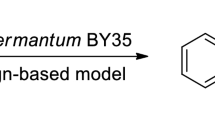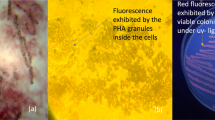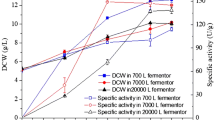Abstract
Enantiomerically pure (S)-1-(4-methoxyphenyl) ethanol is a significant molecule for the production of various drug intermediates. (S)-1-(4-methoxyphenyl) ethanol was synthesized from 4-methoxyacetophenone using Lactobacillus senmaizuke as a biocatalyst. In addition, optimization of experimental conditions is important to analyze the role of culture parameters for catalytic bioreduction reactions. For this particular purpose, the experimental conditions of pH, incubation period, temperature, and agitation speed were investigated with the Box–Behnken experimental design-based proposed optimization model. (S)-1-(4-methoxyphenyl) ethanol, which can be used for the synthesis of antihistamines, including diphenhydramine hydrochloride and loratadine cycloalkyl [b] indoles that have the treatment function for an allergic response, was obtained in > 99% conversion, > 99% enantiomeric excess and 96% yield with whole cells of L. senmaizukei at this optimization conditions: pH = 5.80, the temperature = 29 °C, incubation period = 50 h, and agitation speed = 155 rpm. The bioreduction of 4-methoxyacetophenone efficiency was importantly affected by the quadratic and linear effects of experimental design parameters. Besides, the results demonstrate the importance of design parameters for catalytic bioreduction reactions. It is also concluded that the results show the effectiveness of the Box–Behnken experimental design-based proposed model to obtain optimum operating conditions of design parameters for catalytic bioreduction reactions.


Similar content being viewed by others
References
Gandomkar, S.; Habibi, Z.; Mohammadi, M.; Yousefi, M.; Salimi, S.: Enantioselective resolution of racemic ibuprofen esters using different lipases immobilized on epoxy-functionalized silica. Biocatal. Agric. Biotechnol. 4, 550–554 (2015). https://doi.org/10.1016/j.bcab.2015.10.007
Devendran, S.; Yadav, G.D.: Lipase-catalyzed kinetic resolution of (±)-1-(2-Furyl) ethanol in nonaqueous media. Chirality 26, 286–292 (2014). https://doi.org/10.1002/chir.22317
Baydaş, Y.; Dertli, E.; Şahin, E.: Green synthesis of chiral aromatic alcohols with Lactobacillus kefiri P2 as a novel biocatalyst. Synth. Commun. 50, 1035–1045 (2020). https://doi.org/10.1080/00397911.2020.1729809
Hollmann, F.; Arends, I.W.C.E.; Holtmann, D.: Enzymatic reductions for the chemist. Green Chem. 13, 2285–2314 (2011). https://doi.org/10.1039/C1GC15424A
Corey, E.J.; Shibata, S.; Bakshi, R.K.: An efficient and catalytically enantioselective route to (S)-(-)-phenyloxirane. J. Org. Chem. 53, 2861–2863 (1998)
Touchard, F.; Bernard, M.; Fache, F.; Lemaire, M.: Ureas and thioureas as rh-ligands for the enantioselective hydride transfer reduction of acetophenone. J. Mol. Catal. A Chem. 140, 1–11 (1999). https://doi.org/10.1016/S1381-1169(98)00212-X
Cordes, D.B.; Kwong, T.J.; Morgan, K.A.; Singaram, B.: Chiral styrene oxides from α-haloacetophenones using NaBH4 and TarB-NO2, a chiral Lewis acid. Tetrahedron Lett. 47, 349–351 (2006). https://doi.org/10.1016/j.tetlet.2005.11.011
Mikhailine, A.A.; Morris, R.H.: Effect of the structure of the diamine backbone of p−n−n−p ligands in iron(ii) complexes on catalytic activity in the transfer hydrogenation of acetophenone. Inorg. Chem. 49, 11039–11044 (2010). https://doi.org/10.1021/ic101548j
Pakulski, M.M.; Mahato, S.K.; Bosiak, M.J.; Krzeminski, M.P.; Zaidlewicz, M.: Enantioselective reduction of ketoxime ethers with borane–oxazaborolidines and synthesis of the key intermediate leading to (S)-rivastigmine. Tetrahedron Asymmetry 23, 716–721 (2012). https://doi.org/10.1016/j.tetasy.2012.05.008
Yadav, G.D.; Devendran, S.: Lipase catalyzed synthesis of cinnamyl acetate via transesterification in non-aqueous medium. Process Biochem. 47, 496–502 (2012). https://doi.org/10.1016/j.procbio.2011.12.008
He, P.; Zheng, H.; Liu, X.; Lian, X.; Lin, L.; Feng, X.: Asymmetric reduction of α-amino ketones with a KBH4 solution catalyzed by chiral lewis acids. Chem. A Eur. J. 20, 13482–13486 (2014). https://doi.org/10.1002/chem.201404732
Ni, Y.; Xu, J.H.: Biocatalytic ketone reduction: a green and efficient access to enantiopure alcohols. Biotechnol. Adv. 30, 1279–1288 (2012). https://doi.org/10.1016/j.biotechadv.2011.10.007
Solano, D.M.; Hoyos, P.; Hernáiz, M.J.; Alcántara, A.R.; Sánchez-Montero, J.M.: Industrial biotransformations in the synthesis of building blocks leading to enantiopure drugs. Bioresour. Technol. 115, 196–207 (2012). https://doi.org/10.1016/j.biortech.2011.11.131
Verho, O.; Bäckvall, J.E.: Chemoenzymatic dynamic kinetic resolution: a powerful tool for the preparation of enantiomerically pure alcohols and amines. J. Am. Chem. Soc. 137, 3996–4009 (2015). https://doi.org/10.1021/jacs.5b01031
Engleder, M.; Pichler, H.: On the current role of hydratases in biocatalysis. Appl. Microbiol. Biotechnol. 102, 5841–5858 (2018). https://doi.org/10.1007/s00253-018-9065-7
Qin, F.; Qin, B.; Mori, T.; Wang, Y.; Meng, L.; Zhang, X.; You, S.: Engineering of Candida glabrata ketoreductase 1 for asymmetric reduction of α-halo ketones. ACS Catal. 6, 6135–6140 (2016). https://doi.org/10.1021/acscatal.6b01552
de Miranda, A.S.; Simon, R.C.; Grischek, B.; de Paula, G.C.; Horta, B.A.; de Miranda, L.S.; de Souza, R.O.: Chiral chlorohydrins from the biocatalyzed reduction of chloroketones: chiral building blocks for antiretroviral drugs. Chem. Cat. Chem. 7, 984–992 (2015). https://doi.org/10.1002/cctc.201403023
Chakraborty, A.A.; Phadke, R.P.; Chaudhary, F.A.; Shete, P.S.; Rao, B.S.; Jasani, K.D.: Optimization of redox reactions employing whole cell biocatalysis. World J. Microb. Biotehnol. 21, 221–227 (2005). https://doi.org/10.1007/s11274-004-3620-3
De Carvalho, C.C.: Enzymatic and whole cell catalysis: finding new strategies for old processes. Biotechnol. Adv. 29, 75–83 (2011). https://doi.org/10.1016/j.biotechadv.2010.09.001
Li, J.; Wang, P.; He, J.Y.; Huang, J.; Tang, J.: Efficient biocatalytic synthesis of (R)-[3,5-Bis(Trifluoromethyl)Phenyl] ethanol by a newly isolated Trichoderma Asperellum ZJPH0810 using dual cosubstrate: ethanol and glycerol. Appl. Microbiol. Biotechnol. 97, 6685–6692 (2013). https://doi.org/10.1007/s00253-013-4973-z
Garzón-Posse, F.; Becerra-Figueroa, L.; Hernández-Arias, J.; Gamba-Sánchez, D.: Whole cells as biocatalysts in organic transformations. Molecules 23, 1265 (2018). https://doi.org/10.3390/molecules23061265
Yu, S.; Li, H.; Lu, Y.; Zheng, G.A.: Catalyst from burkholderia cenocepacia for efficient anti-prelog’s bioreduction of 3,5-Bis(Trifluoromethyl) acetophenone. Appl. Biochem. Biotechnol. 184, 1319–1331 (2018). https://doi.org/10.1007/s12010-017-2628-8
Hillier, M.C.; Desrosiers, J.N.; Marcoux, J.F.; Grabowski, E.J.J.: Stereoselective carbon-carbon bond formation via the mitsunobu displacement of chiral secondary benzylic alcohols. Org. Lett. 6, 573–576 (2004). https://doi.org/10.1021/ol036380l
Hillier, M.C.; Marcoux, J.F.; Zhao, D.L.; Grabowski, E.J.J.; McKeown, A.E.; Tillyer, R.D.: Stereoselective formation of carbon–carbon bonds via S(N)2-displacement: synthesis of substituted cycloalkyl b indoles. J. Org. Chem. 70, 8385–8394 (2005). https://doi.org/10.1021/jo051146p
Seayad, A.; Jayasree, S.; Chaudhari, R.V.: Highly efficient catalyst system for the synthesis of 2-arylpropionic acids by carbonylation. Catal. Lett. 61, 99–103 (1999). https://doi.org/10.1023/A:1019064603994
Senboku, H.; Yoneda, K.; Hara, S.: Electrochemical direct carboxylation of benzyl alcohols having an electron-withdrawing group on the phenyl ring: one-step formation of phenylacetic acids from benzyl alcohols under mild conditions. Tetrahedron Lett. 56, 6772–6776 (2015). https://doi.org/10.1016/j.tetlet.2015.10.068
Nakamura, K.; Inoue, Y.; Matsuda, T.; Ohno, A.: Microbial deracemization of 1-arylethanol. Tetrahedron Lett. 36, 6263–6266 (1995). https://doi.org/10.1016/0040-4039(95)01255-G
Wang, W.; Zong, M.H.; Lou, W.Y.: Use of an ionic liquid to improve asymmetric reduction of 4′-methoxyacetophenone catalyzed by immobilized Rhodotorula sp. AS2.2241 cells. J. Mol. Catal. B Enzym. 56, 70–76 (2009). https://doi.org/10.1016/j.molcatb.2008.05.010
Wang, B.; Tang, X.; Liu, J.Y.H.: Escherichia coli BioH: a highly enantioselective and organic solvent tolerant esterase for kinetic resolution of sec-alcohols. Tetrahedron Lett. 5, 6360–6364 (2010). https://doi.org/10.1016/j.tetlet.2010.09.135
Vitale, P.; D’Introno, C.; Perna, F.M.; Perrone, M.G.; Scilimati, A.: Kluyveromyces marxianus CBS 6556 growing cells as a new biocatalyst in the asymmetric reduction of substituted acetophenones. Tetrahedron Asymmetry 24, 389–394 (2013). https://doi.org/10.1016/j.tetasy.2013.02.001
Xu, P.; Cheng, J.; Lou, W.Y.; Zong, M.H.: Using deep eutectic solvents to improve the resolution of racemic 1-(4-methoxyphenyl) ethanol through Acetobacter sp. CCTCC M209061 cell-mediated asymmetric oxidation. RSC Adv. 5, 6357–6364 (2015). https://doi.org/10.1039/C4RA12905A
Wei, P.; Liang, J.; Cheng, J.; Zong, M.H.; Lou, W.Y.: Markedly improving asymmetric oxidation of 1-(4-methoxyphenyl) ethanol with Acetobacter sp. CCTCC M209061 cells by adding deep eutectic solvent in a two-phase system. Microb. Cell Fact. 15, 5 (2016). https://doi.org/10.1186/s12934-015-0407-1
Wang, B.; Zhu, B.; Gong, J.; Weng, J.; Xia, F.; Liu, W.: Resolution of racemic1-(4-methoxyphenyl) ethanol using immobilized lipase with high substrate tolerance. Biochem. Eng. J. 158, 107559 (2020). https://doi.org/10.1016/j.bej.2020.107559
Pereira, R.S.: The use of baker’s yeast in the generation of asymmetric centers to produce chiral drugs and other compounds. Crit. Rev. Biotechnol. 18, 25–64 (1998). https://doi.org/10.1080/0738-859891224211
Braiuca, P.; Ebert, C.; Basso, A.; Linda, P.; Gardossi, L.: Computational methods to rationalize experimental strategies in biocatalysis. Trends Biotechnol. 24, 419–425 (2006). https://doi.org/10.1016/j.tibtech.2006.07.001
Çolak, N.S.; Şahin, E.; Dertli, E.; Yilmaz, M.T.; Taylan, O.: Response surface methodology as optimization strategy for asymmetric bioreduction of acetophenone using whole cell of Lactobacillus senmaizukei. Prep. Biochem. Biotechnol. 49, 884–890 (2019). https://doi.org/10.1080/10826068.2019.1633668
Purutoğlu, K.; İspirli, H.; Yüzer, M.O.; Serencam, H.; Dertli, E.: Diversity and functional characteristics of lactic acid bacteria from traditional kefir grains. Int. J. Dairy Technol. 73, 57–66 (2020). https://doi.org/10.1111/1471-0307.12633
Myers, R.H.; Montgomery, D.C.; Anderson-Cook, C.M.: Response Surface Methodology: Process and Product Optimization Using Designed Experiments, p. 1–12. Wiley, Hoboken (2016)
Özdemir, A.; Cho, B.R.: A nonlinear integer programming approach to solving the robust parameter design optimization problem. Qual. Reliab. Eng. Int. 32, 2859–2870 (2016). https://doi.org/10.1002/qre.1970
Özdemir, A.: D-optimal experimental design for production models in nonstandard experiments. Qual. Reliab. Eng. Int. 36, 1537–1552 (2020). https://doi.org/10.1002/qre.2644
Öksüz, S.; Şahin, E.; Dertli, E.: Synthesis of enantiomerically enriched drug precursors by Lactobacillus paracasei BD 87E6 as a biocatalyst. Chem. Biodivers. 15, e1800028 (2018). https://doi.org/10.1002/cbdv.201800028
Şahin, E.: Production of (R)-1-(1,3-benzodioxol-5-yl)ethanol in high enantiomeric purity by Lactobacillus paracasei BD101. Chirality 30, 189–194 (2018). https://doi.org/10.1002/chir.22782
Nakamura, K.; Yamanaka, R.; Matsuda, T.; Harada, T.: Recent developments in asymmetric reduction of ketones with biocatalysts. Tetrahedron Asymmetry 14, 2659–2681 (2003). https://doi.org/10.1016/S0957-4166(03)00526-3
Mandal, D.; Ahmad, A.; Khan, M.I.; Kumar, R.: Enantioselective bioreduction of acetophenone and its analogous by the fungus Trichothecium sp. J. Mol. Catal. B Enzym. 27, 61–63 (2004). https://doi.org/10.1016/j.molcatb.2003.09.009
Yılmaz, D.; Sahin, E.; Dertli, E.: Highly enantioselective production of chiral secondary alcohols using Lactobacillus paracasei BD 101 as a new whole cell biocatalyst and evaluation of their antimicrobial effects. Chem. Biodivers. 14, e1700269 (2017). https://doi.org/10.1002/cbdv.201700269
Şahin, E.; Dertli, E.: Highly enantioselective production of chiral secondary alcohols with Candida zeylanoides as a new whole cell biocatalyst. Chem. Biodivers. 14, e1700121 (2017). https://doi.org/10.1002/cbdv.201700121
Prelog, V.: Specification of the stereospecificity of some oxido-reductases by diamond lattice sections. Pure Appl. Chem. 9, 119–130 (1964). https://doi.org/10.1351/pac196409010119
Acknowledgements
The writers are grateful to the Bayburt University Central Research Laboratory for evaluating HPLC.
Author information
Authors and Affiliations
Corresponding author
Supplementary Information
Below is the link to the electronic supplementary material.
Rights and permissions
About this article
Cite this article
Kavi, M., Özdemir, A., Dertli, E. et al. Optimization of Biocatalytic Production of Enantiopure (S)-1-(4-Methoxyphenyl) Ethanol with Lactobacillus senmaizuke Using the Box–Behnken Design-Based Model. Arab J Sci Eng 47, 5849–5858 (2022). https://doi.org/10.1007/s13369-021-05769-3
Received:
Accepted:
Published:
Issue Date:
DOI: https://doi.org/10.1007/s13369-021-05769-3




